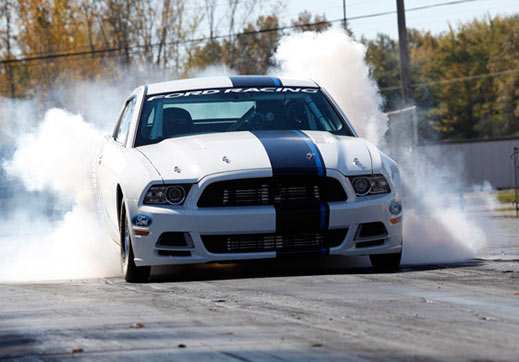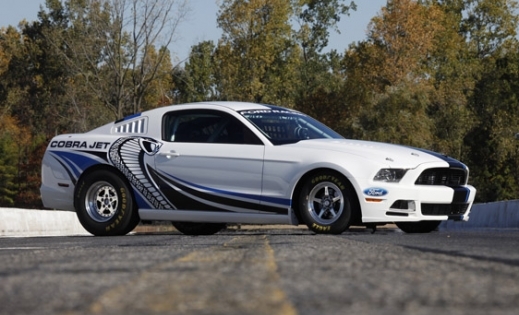Tire-frying torque. That’s how Jesse Kershaw, Ford Racing drag racing competition manager, described the performance of the Cobra Jet Twin Turbo concept that was introduced at the SEMA Show in Las Vegas on October 30, 2012.
The original Cobra Jets made headlines back in 1968, when Ford brought a fleet of the 428-powered Mustangs to the NHRA Winternationals and quickly changed the face of production-based drag racing. Forty years later, Ford Racing revived the iconic Cobra Jet name for a limited run of race-prepped Mustangs to compete in the NHRA Stock and Super Stock classes. Right out of the gate, the new Cobra
Jet was winning races and setting records, so Ford has continued to offer the drag racer, typically in batches of 50 cars on a first-come, first-served basis.
The contemporary Cobra Jet has evolved since that 2008 model, and for 2013 is offered with either a naturally aspirated or supercharged 5.0L V8. The Twin-Turbo Concept is also 5.0 powered but takes forced induction in a different direction. Unlike a belt-driven supercharger, which requires engine horsepower to operate, a turbocharger is driven by exhaust gas, so there is no parasitic power loss.
Most drag-race turbochargers have fairly large housings to maximize airflow to the engine. The turbos on the Cobra Jet Concept, however, are surprisingly small, and are in fact based on the turbos used on the 2.0L EcoBoost™ engine in the new Ford Focus ST. These units are small for a reason: to cut down on turbo lag. They are also filled with lightweight titanium aluminide turbine wheels – riding on ball bearings – that essentially halve the rotational inertia of the stock Focus turbos. Between their small size and featherweight components, the turbochargers can quickly spool up to 150,000 rpm and provide nearly instantaneous torque.
 Ford has applied turbo technology, via its EcoBoost engines, to nearly every vehicle category in its lineup, so turbocharging the Cobra Jet “was a logical extension of what we’re doing with production-based and racing technology around the world,” Jesse explained. “We have so much expertise in turbocharging, in everything from diesels to direct-injection gas engines, that it just made sense.”
Ford has applied turbo technology, via its EcoBoost engines, to nearly every vehicle category in its lineup, so turbocharging the Cobra Jet “was a logical extension of what we’re doing with production-based and racing technology around the world,” Jesse explained. “We have so much expertise in turbocharging, in everything from diesels to direct-injection gas engines, that it just made sense.”
So, how much power will this 5.0 put out? Jesse just smiled and offered the “tire frying” comment mentioned above. Power numbers are still a work in progress, apparently, though Ford Racing is anticipating this car to make high 8-second quarter-mile passes—a bar already set by no fewer than 10 Cobra Jet race teams.
Will this twin-turbo model join the Cobra Jet fleet? Jesse wouldn’t commit, and indicated that Ford Racing is still investigating the technology. “We still have to put some development time in the program. Our customers have an expectation for horsepower, consistency and durability, and we still need to do some more work on our end to deliver to those expectations.”
However, racers interested in the turbocharged Mustang can go to the Ford Racing website, where they can be put on a waiting list should the Twin-Turbo Concept become reality. The car even has its own part number: M-FR500-CJ.

